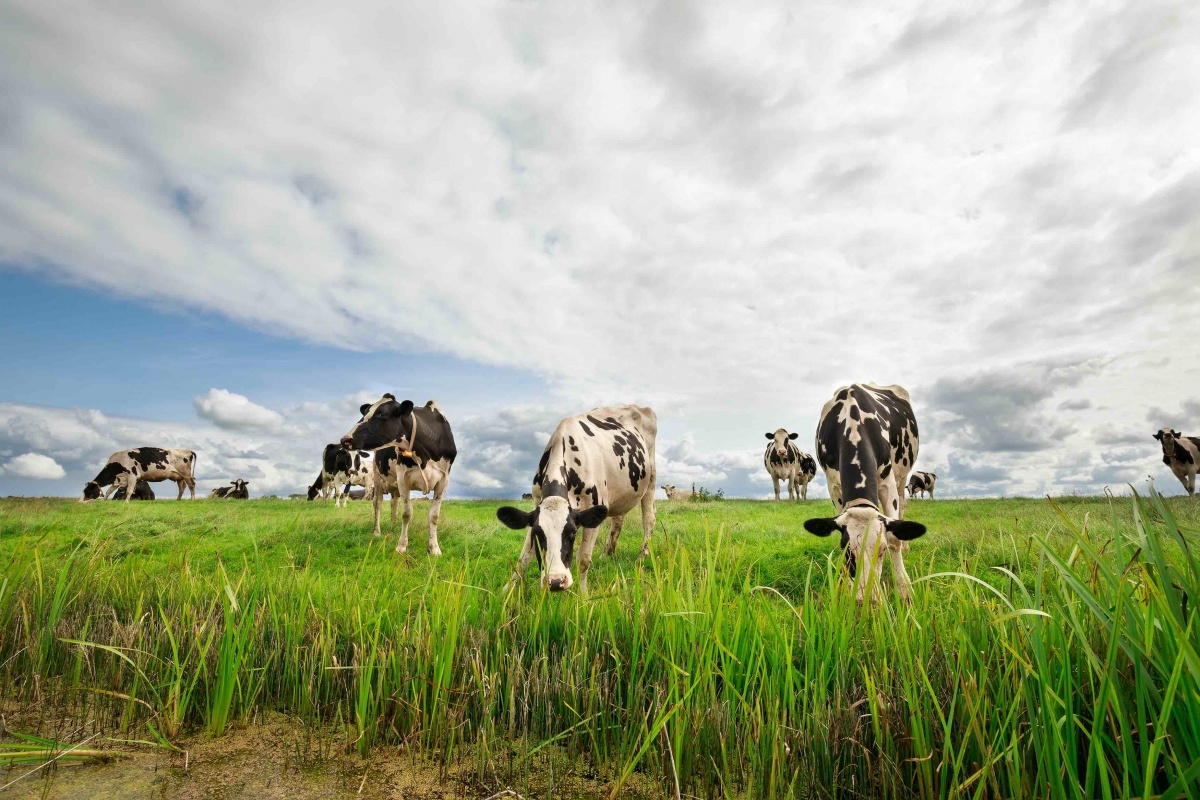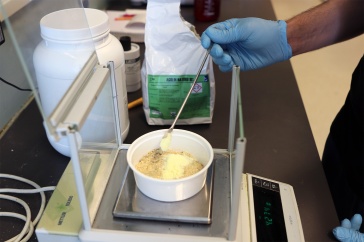New research from NHAES scientist and Agriculture, Nutrition and Food Systems department faculty member Andre Brito highlights farm management, higher milk production factors of growing organic grass-fed dairy industry.
How is organic grass-fed management different?
There is some overlap in the practices used in organic grass-fed (OGF) management and more traditional organic dairy operations. Both types of operations must follow USDA protocols of not using antibiotics, hormones or genetically modified organism feed, and that organic dairy cows must spend a minimum of 120 days at pasture per year and receive at least 30 percent of their diet from fresh pasture grass. Additionally, organic cows must live in an organically certified environment for at least a year before their milk can be sold as organic.
Dairies managing as organic grass-fed take these standards a step further by completely eliminating grain from the diets of OGF cows and only feeding them foraged foods, like pasture grass and clover, hay, or silage—preserved or pickled pasture greens stored for winter use. OGF managed cows must spend at least 150 days per year grazing in pastures and receive approximately 60 percent of their total diet from pasture.
The U.S. organic dairy market is experiencing a major shift. After expansion during the 2000s and 2010s, the U.S. sales of organic milk have dropped steadily over the past 5 years—by 2.3 percent in 2022 alone—and prices declined by 25% between 2017 and 2022, according to data from the USDA’s Agricultural Marketing Service. The slump is largely due to the market mismatch between the growing organic milk production and lower demand for all dairy milk in the U.S. However, challenges for New Hampshire’s small organic dairy farms, which have 100 or fewer milking cows, have been exacerbated by increasing feed costs and large organic milk processors, such as Horizon Organic and Maple Hill Creamery, recently transitioning to purchasing more milk from larger dairy operations in other U.S. regions.
Despite these challenges, New England organic dairy farmers can increase their sustainability and market competitiveness is through innovation in their management strategies, according to Andre Brito, a scientist with the NH Agricultural Experiment Station and associate professor in the Agriculture, Nutrition and Food Systems department.
One area of the organic dairy market that has not only seen growth, but rapid recent expansion is the organic grass-fed (OGF) sector. OGF managed farms must adhere to more stringent protocols than a traditional organic dairy operation. But there are two major benefits to OGF management, explains Brito, including greater resiliency to rising costs of feed grain and a generally higher price than regular organic milk.
Until recently, however, the organic grass-fed management systems have had little research directed to identifying best practices for higher milk production. Brito was recently one of several Northeast scientists to contribute to a paper in Renewable Agriculture and Food Systems journal that studied management techniques of OGF dairy farmers. Led by researchers at the University of Vermont, the study provides a better understanding of this sector and its operations and needs.

The research included a national survey of 167 OGF farmers, which gathered information about general farming practices, herd management, and foraging and grazing management. The key findings indicated that the majority of OGF dairy farmers belong to the plain, or Amish-Mennonite, community, and that farms with higher milk production most often used Holstein cows, employed an intense regimen of pasture rotation, and supplemented grazing diets with molasses and kelp meal.
“Pasture and forage are the cheapest source of feed in a dairy farm as imported grains can be very expensive. With the margin of profitability declining over time for organic dairy farmers, one solution has been to reduce feed costs and shift to 100 percent forage diets and produce a type of milk that has a higher price point.”
“Pasture and forage are the cheapest source of feed in a dairy farm as imported grains can be very expensive,” he adds. “With the margin of profitability declining over time for organic dairy farmers, one solution has been to reduce feed costs and shift to 100 percent forage diets and produce a type of milk that has a higher price point.”
Responses from the survey were generally concentrated in the Northeast (particularly New York) and the Midwest, suggesting that the majority of OGF farms are likely located in those areas, says Brito. The researchers are seeing more and more organic dairy operations transitioning to OGF management, as one way to find a competitive advantage in an otherwise stagnating organic dairy industry.
“I’m positive that the organic dairy sector in New England allowed, and is still allowing, a lot of farmers to remain in business,” Brito says. “Otherwise, those smaller operations wouldn’t be viable economically.”
Brito’s and others’ research into OGF management is adding another tool in dairy farmers’ toolbox to allow many small and medium New England dairy farms – in some cases, farms that have been run by the same families for generations – to remain competitive and resilient.
This material is based on work supported by the NH Agricultural Experiment Station through joint funding from the USDA National Institute of Food and Agriculture (under Hatch award number 1017808) and the state of New Hampshire.
You can read the published article, An overview of organic, grass-fed dairy farm management and factors related to higher milk production, in Vol. 36, Issue 4 of Renewable Agriculture and Food Systems.
-
Written By:
Nicholas Gosling '06 | COLSA/NH Agricultural Experiment Station | nicholas.gosling@unh.edu

















































